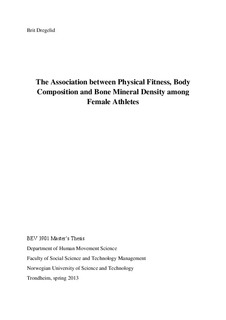The Association between Physical Fitness, Body Composition and Bone Mineral Density among Female Athletes
Master thesis
Permanent lenke
http://hdl.handle.net/11250/271546Utgivelsesdato
2013Metadata
Vis full innførselSamlinger
Sammendrag
Background: Research have suggested that endurance female athletes tend to have lower bone mineral density (BMD) than power and strength athletes, as a result of maintaining low body weight in addition to perform. This study intends to investigate the association between physical fitness by power and endurance measurements, body composition and BMD. In addition, it will address the differences in BMD measured in female football players, handball players and cross-country skiers.
Methods: A cross-sectional study of 57 Norwegian female athletes aged between 18 and 36 years (mean age 22.6 years) was conducted. The sample consisted of 24 football players, 17 handball players and 16 cross-country skiers. For physical fitness examinations, a graded VO₂max (ml/kg/min) test on treadmill, squat jump on a power plate and bench press with free weights were conducted. Body weight and height was measured and BMI calculated from the aforementioned variables. Lean body mass, body fat percentage and BMD (g/cm²) was measured using Dual- Energy X-ray Absorptiometry. BMD was obtained from four different regions, in addition to total body BMD: Ward’s triangle, Trochanter, femoral neck and lumbar region (L1-L4).
Results: Significant association between body composition and BMD was observed for all subjects combined. Also, significant associations between the physical fitness tests and BMD were obtained. Differences in body composition and physical fitness level among the athletes indicated that the cross-country skiers had lower body weight, BMI, lean body mass and body fat percentage. Cross-country skiers also had the highest mean oxygen consumption among the female athletes and also the lowest BMD in all regions. Handball players had higher mean body weight, BMI, lean body mass and fat percentage. Handball players also had the higher mean BMD values for all regions measured.
Conclusion: Body composition was strongly associated with BMD in all regions measured. Subjects with high oxygen had lower BMD measurements in all regions while subjects with high muscular power in lower body had the highest BMD measurements in all regions. Also, differences in BMD between the three sports suggested that cross-country skiers have lower BMD values than both football players and handball players, in all regions measured.
Keywords: Female athletes, physical fitness, body composition, bone mineral density (BMD).
